TOYOTA PRIUS C 2013 NHP10 / 1.G Manual Online
Manufacturer: TOYOTA, Model Year: 2013, Model line: PRIUS C, Model: TOYOTA PRIUS C 2013 NHP10 / 1.GPages: 556, PDF Size: 8.88 MB
Page 81 of 556
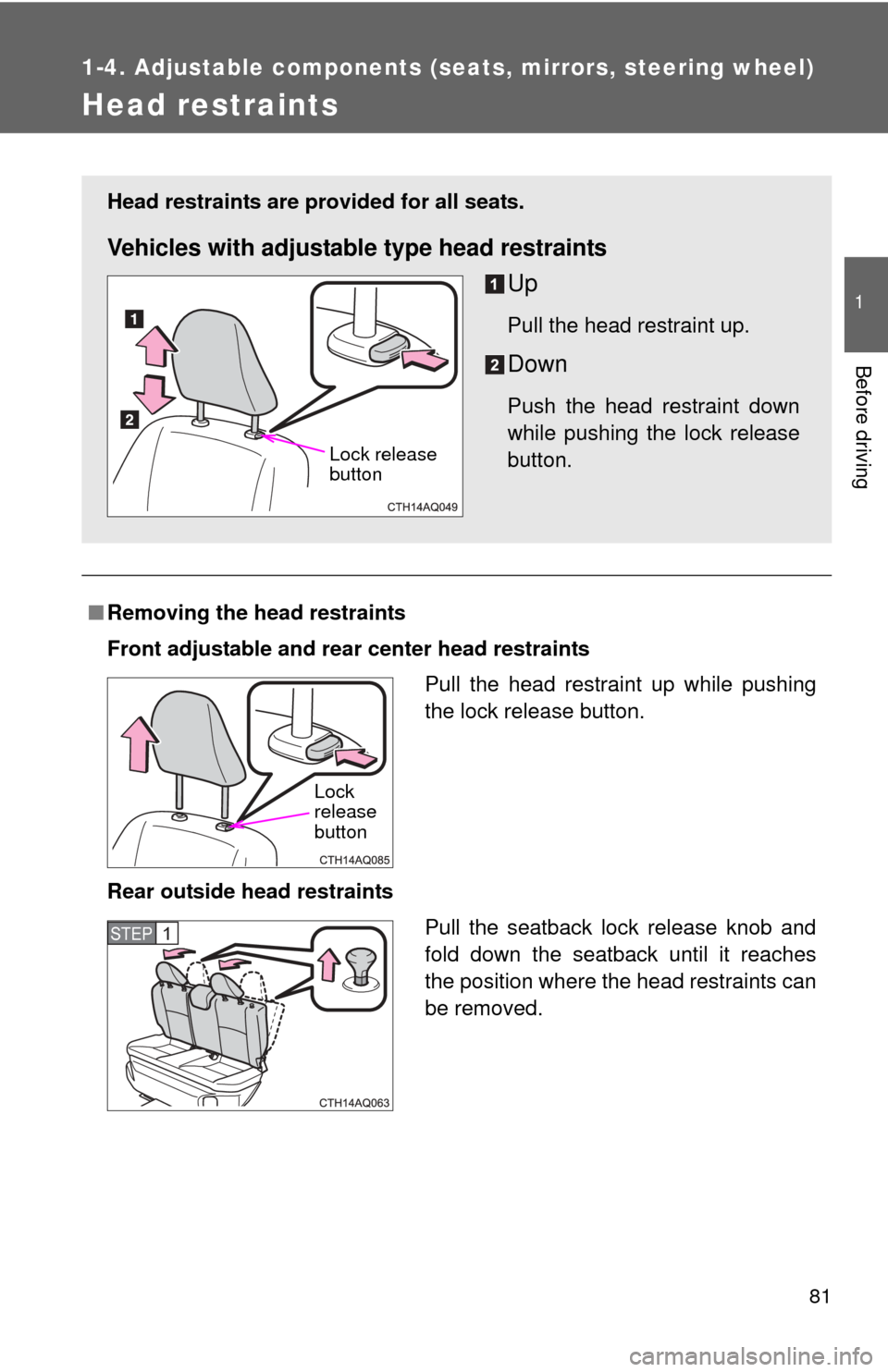
81
1
1-4. Adjustable components (seats, mirrors, steering wheel)
Before driving
Head restraints
■Removing the head restraints
Front adjustable and rear center head restraints
Rear outside head restraints
Head restraints are provided for all seats.
Vehicles with adjustable type head restraints Up
Pull the head restraint up.
Down
Push the head restraint down
while pushing the lock release
button.
Lock release
button
Pull the head restraint up while pushing
the lock release button.
Lock
release
button
Pull the seatback lock release knob and
fold down the seatback until it reaches
the position where the head restraints can
be removed.STEP1
Page 82 of 556
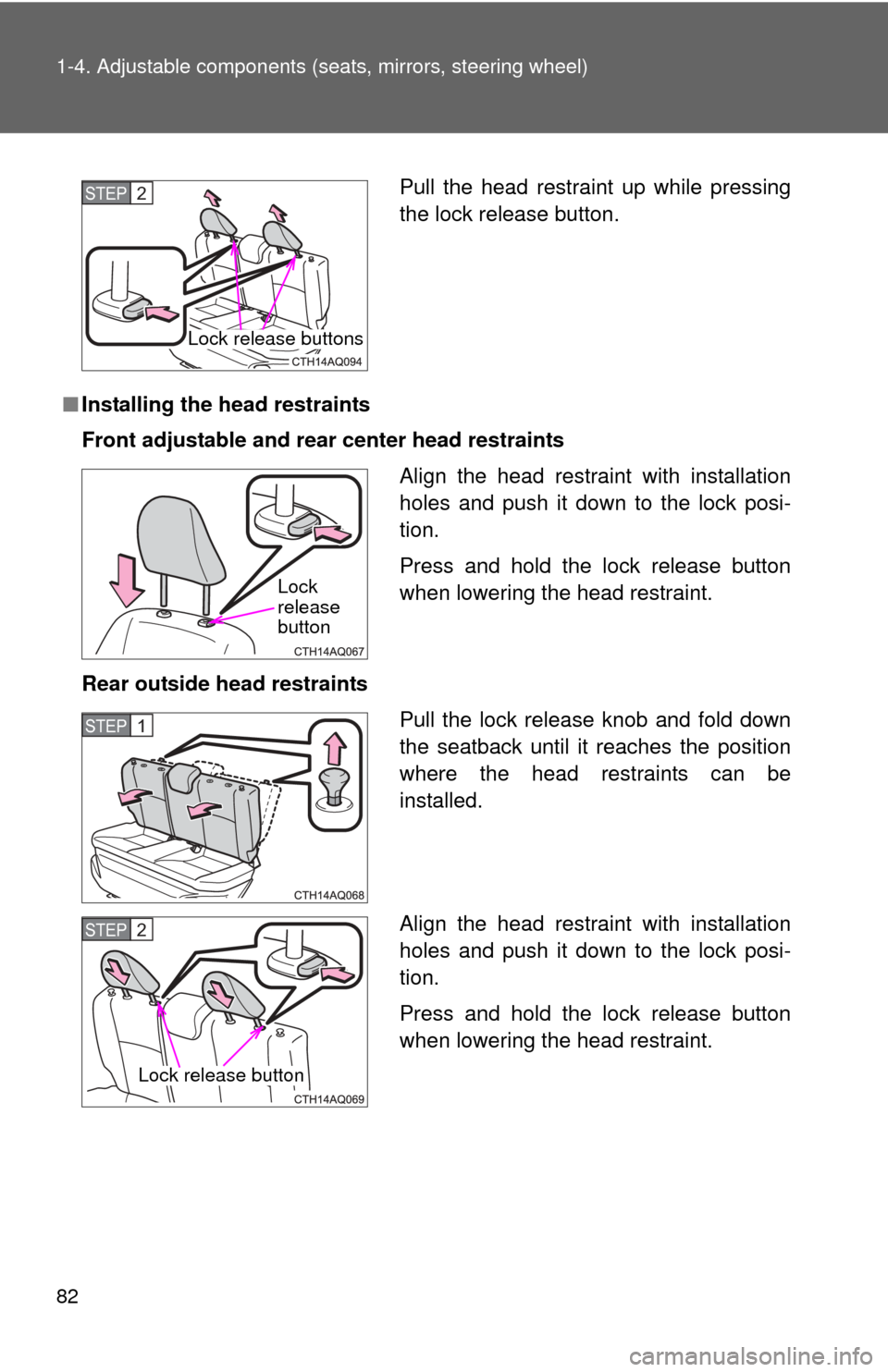
82 1-4. Adjustable components (seats, mirrors, steering wheel)
■Installing the head restraints
Front adjustable and rear center head restraints
Rear outside head restraints
Pull the head restraint up while pressing
the lock release button.STEP2
Lock release buttons
Align the head restraint with installation
holes and push it down to the lock posi-
tion.
Press and hold the lock release button
when lowering the head restraint.
Lock
release
button
Pull the lock release knob and fold down
the seatback until it reaches the position
where the head restraints can be
installed.
Align the head restraint with installation
holes and push it down to the lock posi-
tion.
Press and hold the lock release button
when lowering the head restraint.STEP1
STEP2
Lock release button
Page 83 of 556
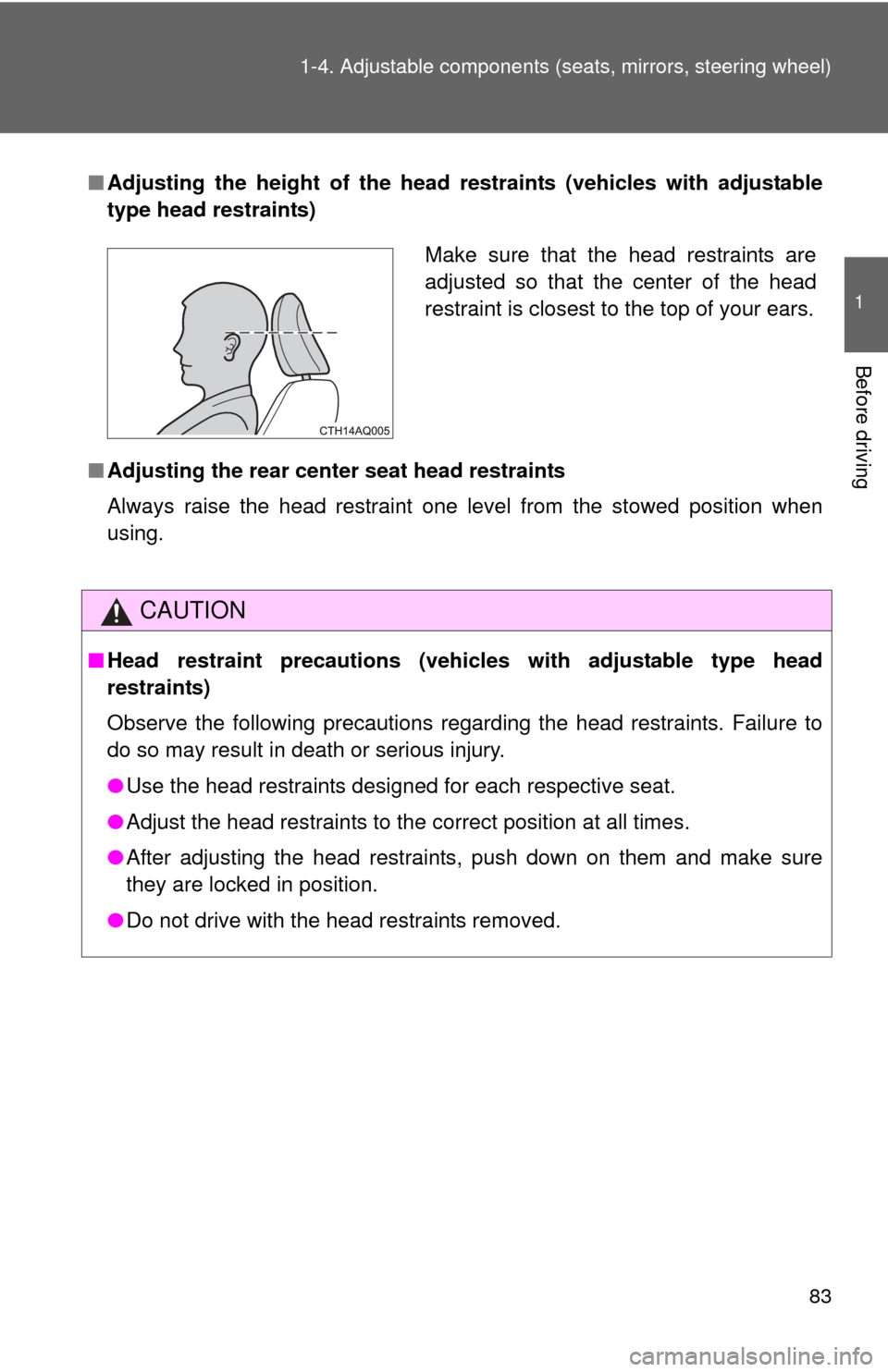
83
1-4. Adjustable components (s
eats, mirrors, steering wheel)
1
Before driving
■Adjusting the height of the head re straints (vehicles with adjustable
type head restraints)
■ Adjusting the rear cent er seat head restraints
Always raise the head restraint one level from the stowed position when
using.
CAUTION
■ Head restraint precautions (vehicles with adjustable type head
restraints)
Observe the following precautions regarding the head restraints. Failure to
do so may result in death or serious injury.
●Use the head restraints designed for each respective seat.
● Adjust the head restraints to the correct position at all times.
● After adjusting the head restraints, push down on them and make sure
they are locked in position.
● Do not drive with the head restraints removed.
Make sure that the head restraints are
adjusted so that the center of the head
restraint is closest to the top of your ears.
Page 84 of 556
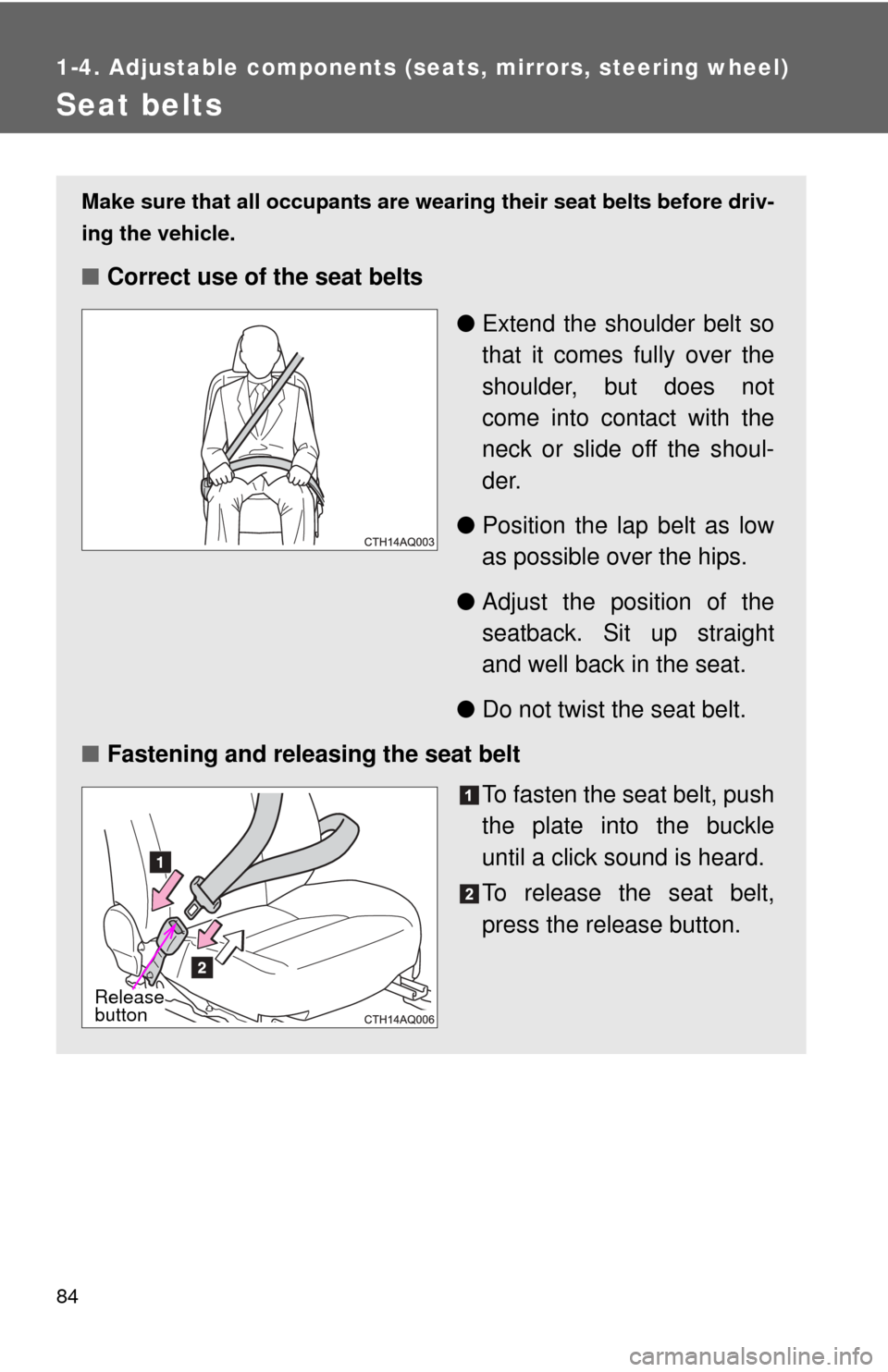
84
1-4. Adjustable components (seats, mirrors, steering wheel)
Seat belts
Make sure that all occupants are wearing their seat belts before driv-
ing the vehicle.
■Correct use of the seat belts
●Extend the shoulder belt so
that it comes fully over the
shoulder, but does not
come into contact with the
neck or slide off the shoul-
der.
● Position the lap belt as low
as possible over the hips.
● Adjust the position of the
seatback. Sit up straight
and well back in the seat.
● Do not twist the seat belt.
■ Fastening and releasing the seat belt
To fasten the seat belt, push
the plate into the buckle
until a click sound is heard.
To release the seat belt,
press the release button.
Release
button
Page 85 of 556
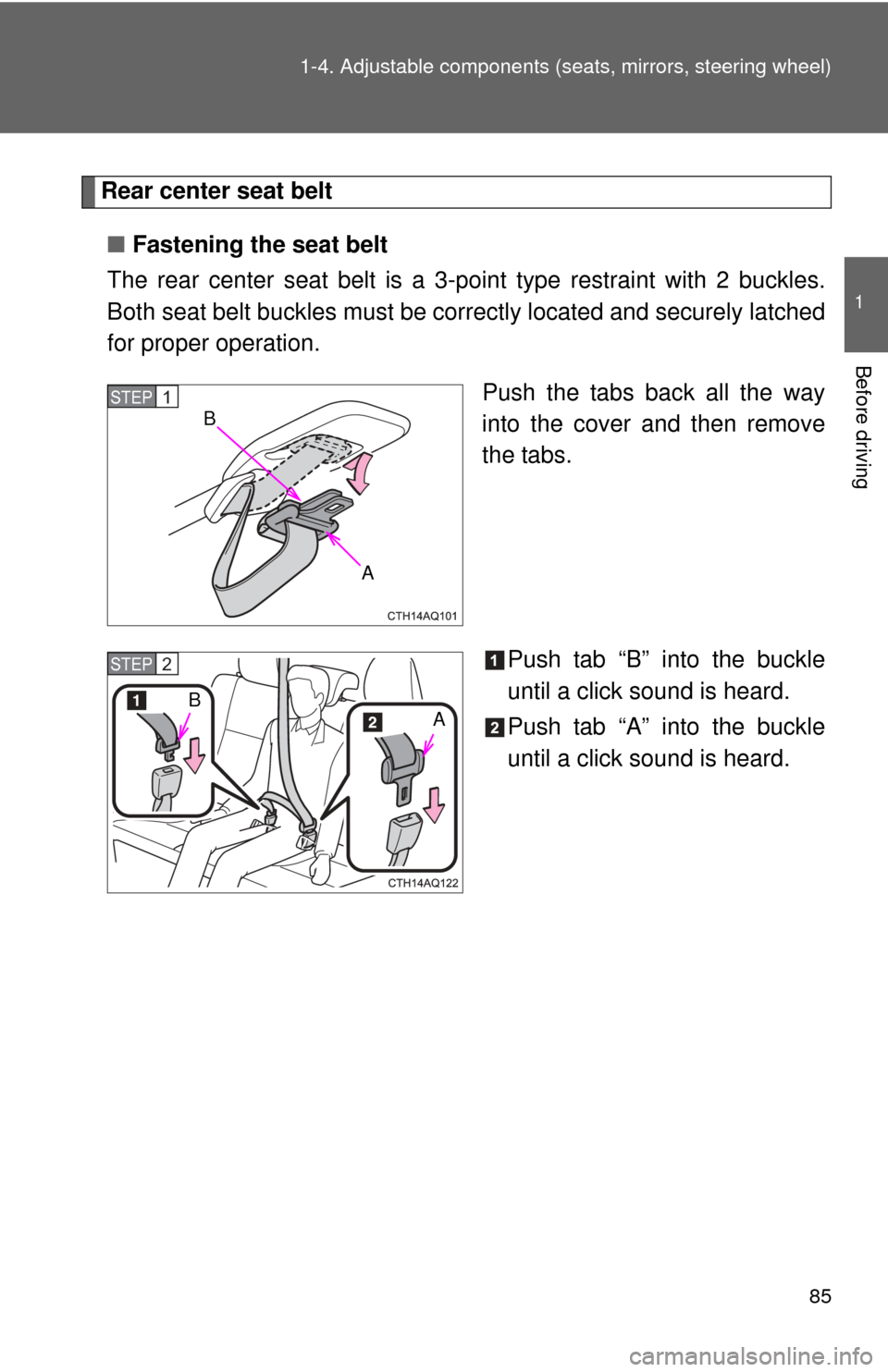
85
1-4. Adjustable components (s
eats, mirrors, steering wheel)
1
Before driving
Rear center seat belt
■ Fastening the seat belt
The rear center seat belt is a 3- point type restraint with 2 buckles.
Both seat belt buckles must be co rrectly located and securely latched
for proper operation.
Push the tabs back all the way
into the cover and then remove
the tabs.
Push tab “B” into the buckle
until a click sound is heard.
Push tab “A” into the buckle
until a click sound is heard.
B
A
STEP1
STEP2
B A
Page 86 of 556
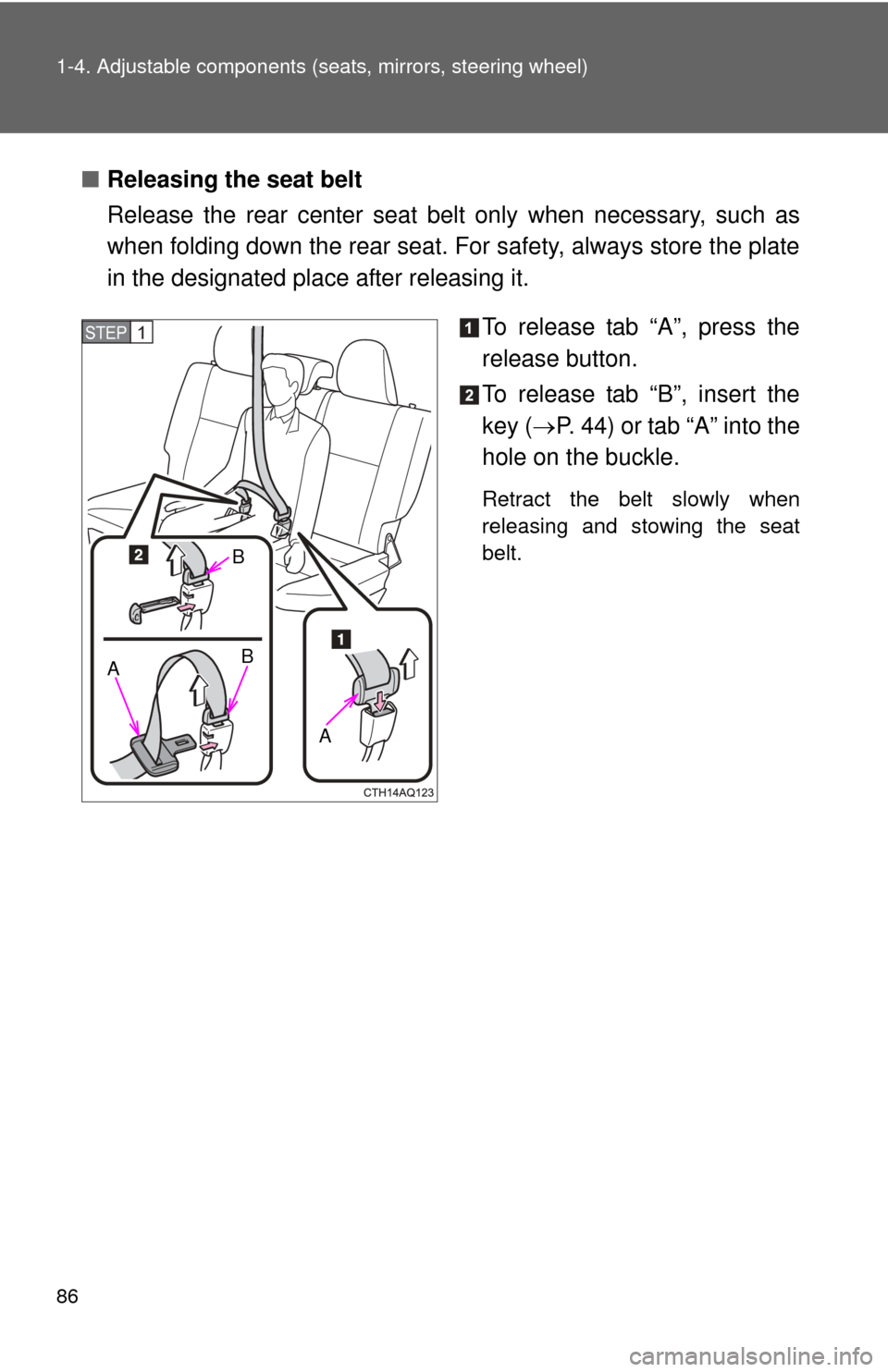
86 1-4. Adjustable components (seats, mirrors, steering wheel)
■Releasing the seat belt
Release the rear center seat belt only when necessary, such as
when folding down the rear seat. For safety, always store the plate
in the designated place after releasing it.
To release tab “A”, press the
release button.
To release tab “B”, insert the
key (P. 44) or tab “A” into the
hole on the buckle.
Retract the belt slowly when
releasing and stowing the seat
belt.
STEP1
A
A
B
B
Page 87 of 556
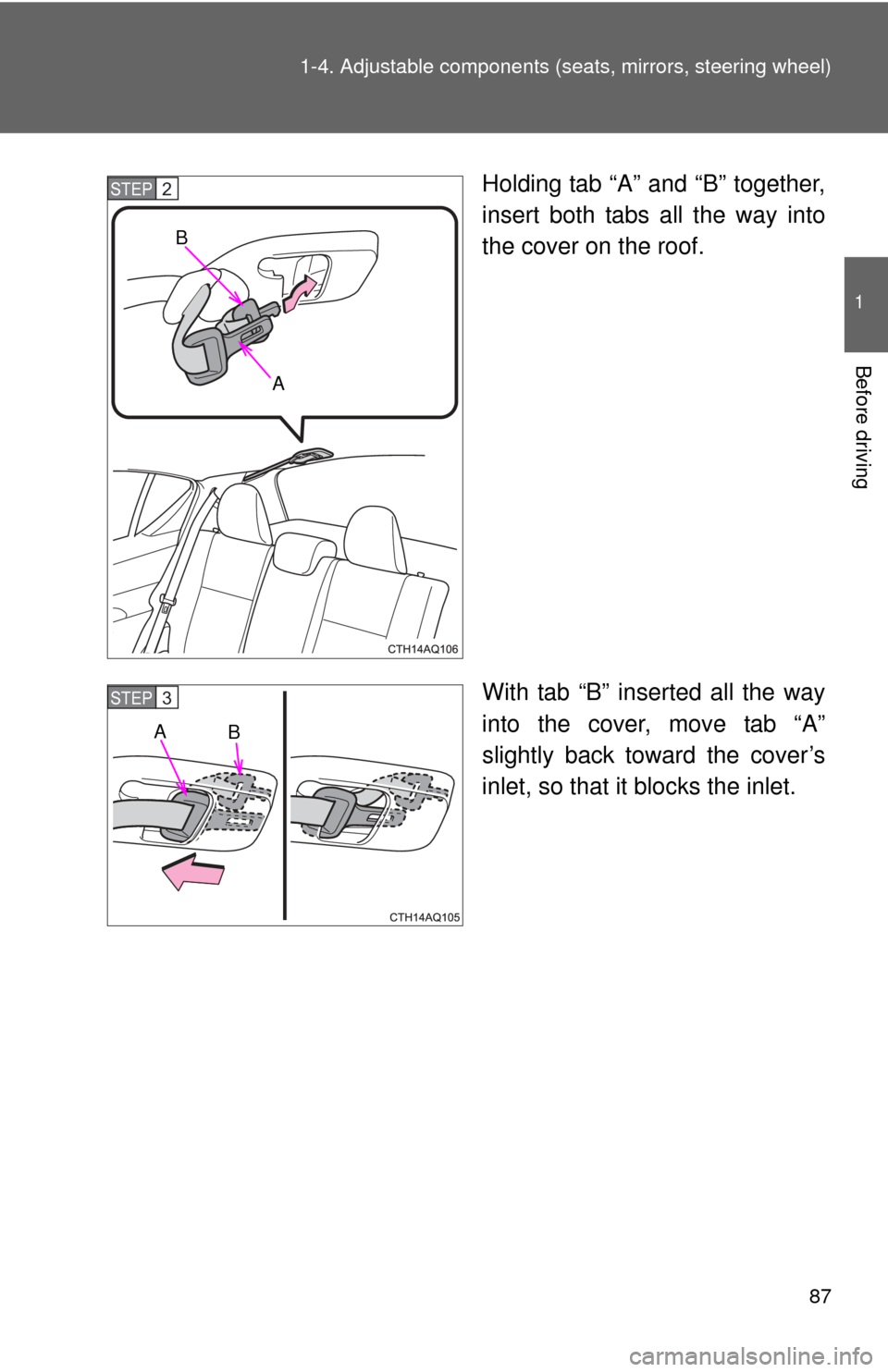
87
1-4. Adjustable components (s
eats, mirrors, steering wheel)
1
Before driving
Holding tab “A” and “B” together,
insert both tabs all the way into
the cover on the roof.
With tab “B” inserted all the way
into the cover, move tab “A”
slightly back toward the cover’s
inlet, so that it blocks the inlet.
B
A
STEP2
STEP3
BA
Page 88 of 556
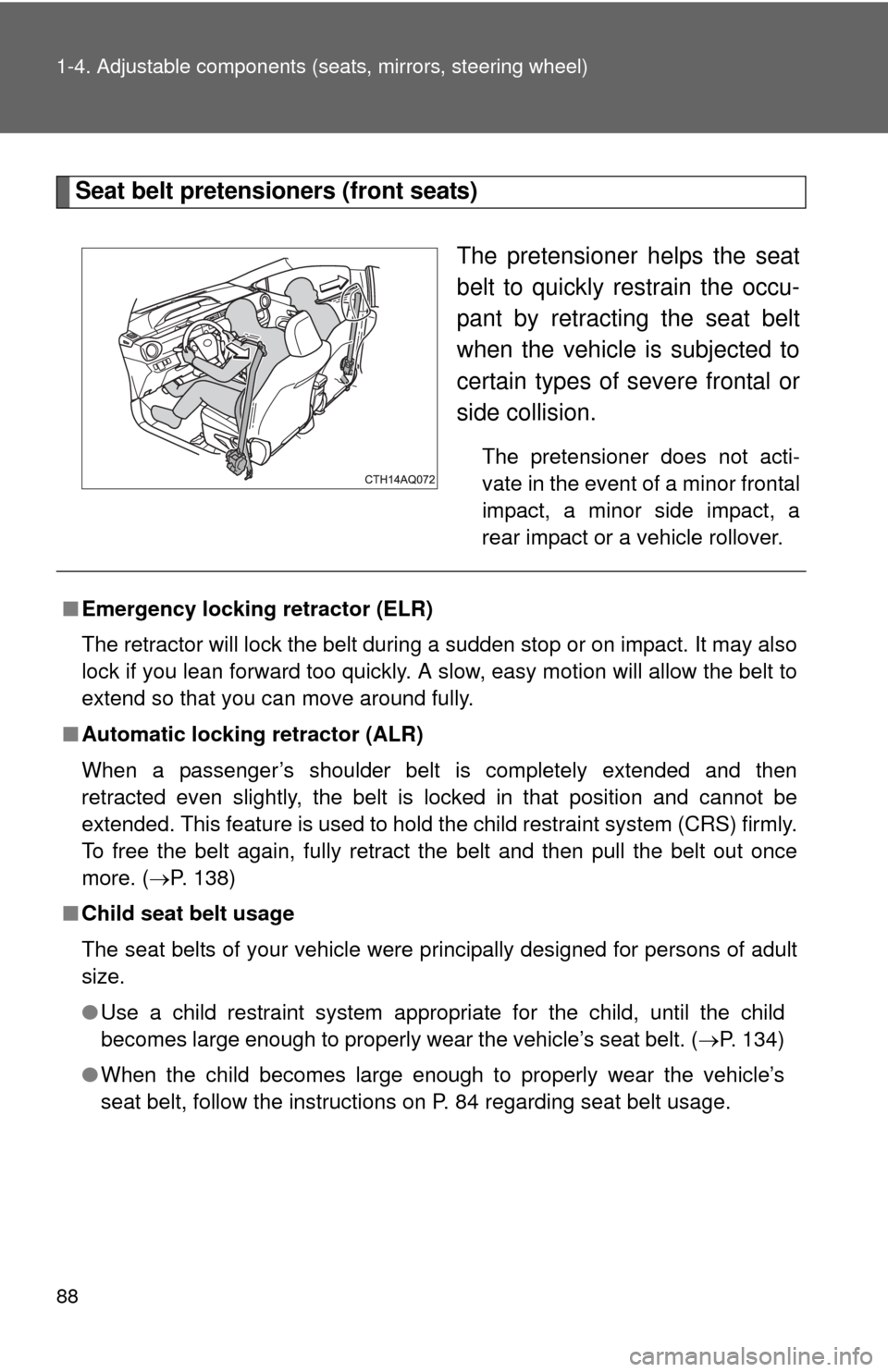
88 1-4. Adjustable components (seats, mirrors, steering wheel)
Seat belt pretensioners (front seats)
The pretensioner helps the seat
belt to quickly restrain the occu-
pant by retracting the seat belt
when the vehicle is subjected to
certain types of severe frontal or
side collision.
The pretensioner does not acti-
vate in the event of a minor frontal
impact, a minor side impact, a
rear impact or a vehicle rollover.
■Emergency locking retractor (ELR)
The retractor will lock the belt during a sudden stop or on impact. It may also
lock if you lean forward too quickly. A slow, easy motion will allow the belt to
extend so that you can move around fully.
■ Automatic locking retractor (ALR)
When a passenger’s shoulder belt is completely extended and then
retracted even slightly, the belt is locked in that position and cannot be
extended. This feature is used to hold the child restraint system (CRS) firmly.
To free the belt again, fully retract the belt and then pull the belt out once
more. ( P. 138)
■ Child seat belt usage
The seat belts of your vehicle were principally designed for persons of adult
size.
●Use a child restraint system appropriate for the child, until the child
becomes large enough to properly wear the vehicle’s seat belt. ( P. 134)
● When the child becomes large enough to properly wear the vehicle’s
seat belt, follow the instructions on P. 84 regarding seat belt usage.
Page 89 of 556
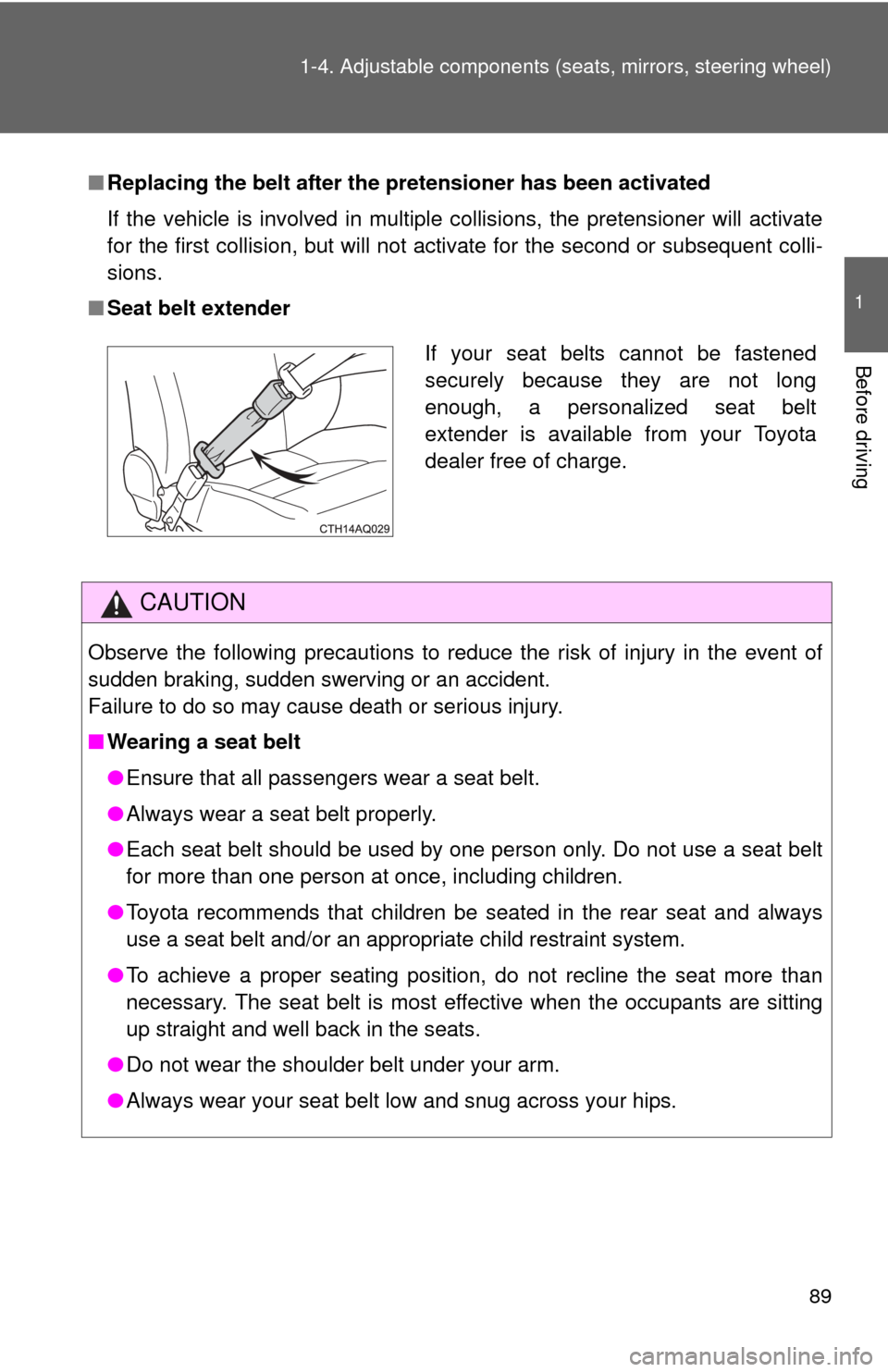
89
1-4. Adjustable components (s
eats, mirrors, steering wheel)
1
Before driving
■Replacing the belt after the pretensioner has been activated
If the vehicle is involved in multiple collisions, the pretensioner will activate
for the first collision, but will not activate for the second or subsequent colli-
sions.
■ Seat belt extender
CAUTION
Observe the following precautions to reduce the risk of injury in the event of
sudden braking, sudden swerving or an accident.
Failure to do so may cause death or serious injury.
■Wearing a seat belt
●Ensure that all passengers wear a seat belt.
● Always wear a seat belt properly.
● Each seat belt should be used by one person only. Do not use a seat belt
for more than one person at once, including children.
● Toyota recommends that children be seated in the rear seat and always
use a seat belt and/or an appropriate child restraint system.
● To achieve a proper seating position, do not recline the seat more than
necessary. The seat belt is most effective when the occupants are sitting
up straight and well back in the seats.
● Do not wear the shoulder belt under your arm.
● Always wear your seat belt low and snug across your hips.
If your seat belts cannot be fastened
securely because they are not long
enough, a personalized seat belt
extender is available from your Toyota
dealer free of charge.
Page 90 of 556
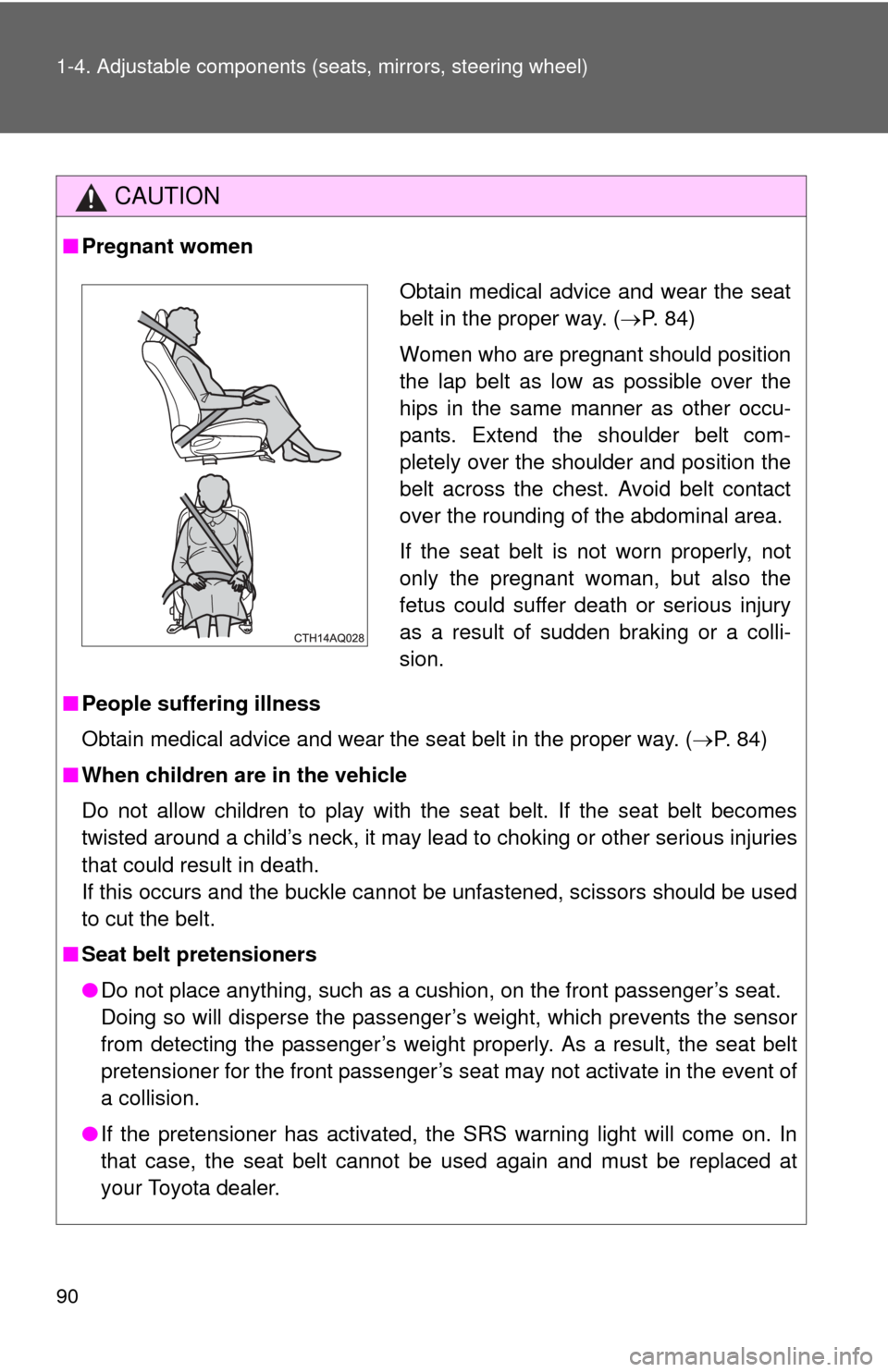
90 1-4. Adjustable components (seats, mirrors, steering wheel)
CAUTION
■Pregnant women
■ People suffering illness
Obtain medical advice and wear the seat belt in the proper way. ( P. 84)
■ When children are in the vehicle
Do not allow children to play with the seat belt. If the seat belt becomes
twisted around a child’s neck, it may lead to choking or other serious injuries
that could result in death.
If this occurs and the buckle cannot be unfastened, scissors should be used
to cut the belt.
■ Seat belt pretensioners
●Do not place anything, such as a cushion, on the front passenger’s seat.
Doing so will disperse the passenger’s weight, which prevents the sensor
from detecting the passenger’s weight properly. As a result, the seat belt
pretensioner for the front passenger’s seat may not activate in the event of
a collision.
● If the pretensioner has activated, the SRS warning light will come on. In
that case, the seat belt cannot be used again and must be replaced at
your Toyota dealer.
Obtain medical advice and wear the seat
belt in the proper way. ( P. 84)
Women who are pregnant should position
the lap belt as low as possible over the
hips in the same manner as other occu-
pants. Extend the shoulder belt com-
pletely over the shoulder and position the
belt across the chest. Avoid belt contact
over the rounding of the abdominal area.
If the seat belt is not worn properly, not
only the pregnant woman, but also the
fetus could suffer death or serious injury
as a result of sudden braking or a colli-
sion.